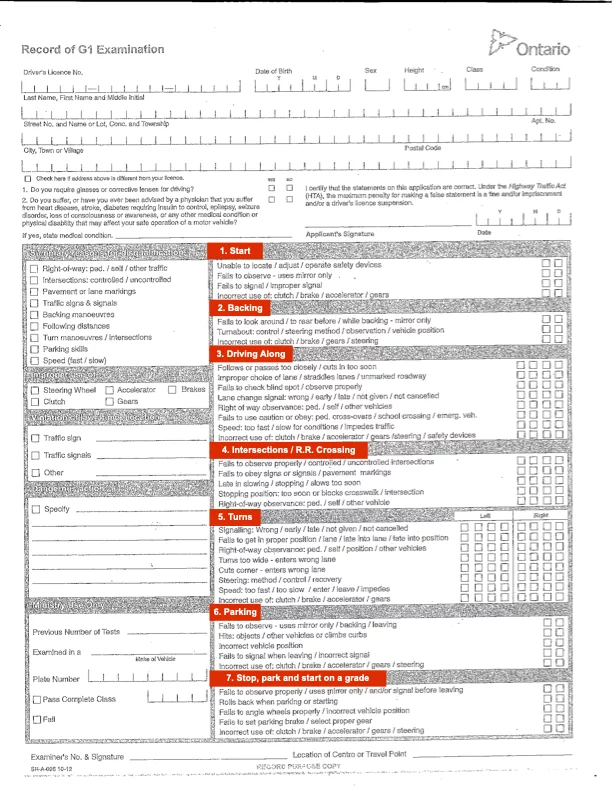G2 Test Examiner Sheet Guide
Published on | Updated
When you take your G2 road test in Ontario, the examiner uses a standardized score sheet to track every move you make. The sheet looks simple, but it covers dozens of small habits that add up to a pass or fail. Let’s break down how the sheet works, what examiners mark, and the most common mistakes Windsor drivers make on the G2 test.

How the G2 Road Test Scoring System Works
- [OK] – Correct
- [✔] – Minor error (–2 points)
- [X] – Major error (–4 points)
- [R] – Unsafe action at a railway crossing (automatic fail)
- [//] – Not tested
Tip: You don't need a perfect sheet. A few small mistakes are fine, examiners care most about safe, consistent driving. However, accumulating too many minor errors or making even one major unsafe error can result in failure.
1. Start
- Unable to locate / adjust / operate safety devices (seatbelt, mirrors, lights, etc.)
- Fails to observe - uses mirror only
- Fails to signal / improper signal
- Incorrect use of: clutch / brake / accelerator / gears
2. Backing
- Fails to look around / to rear before / while backing - mirror only
- Turnabout: control / steering method / observation / vehicle position
- Incorrect use of: clutch / brake / gears / steering
3. Driving Along
- Follows or passes too closely / cuts in too soon
- Improper choice of lane / straddles lanes / unmarked roadway
- Fails to check blind spot / observe properly
- Lane change signal: wrong / early / late / not given / not cancelled
- Right of way observance: ped. / self / other vehicles
- Fails to use caution or obey: ped. cross-overs / school crossing / emerg. veh.
- Speed: too fast / slow for conditions / impedes traffic
- Incorrect use of: clutch / brake / accelerator / gears / steering / safety devices
4. Intersections & Railroad (R.R.) Crossings
- Fails to observe properly / controlled / uncontrolled intersections
- Fails to obey signs or signals / pavement markings
- Late in slowing / stopping / slows too soon
- Stopping position: too soon or blocks crosswalk / intersection
- Right-of-way observance: ped. / self / other vehicle
5. Turns
- Left turn process: mirror → signal → check intersection & crosswalk → blindspot check → enter the correct lane → cancel signal (most cars will auto shut off the signal after the turn) → match the posted speed when safe → move to right lane after speed limit is reached
- Signalling: Wrong / early / late / not given / not cancelled
- Fails to get in proper position / lane / late into lane / late into position
- Right-of-way observance: ped. / self / position / other vehicles
- Turns too wide - enters wrong lane
- Cuts corner - enters wrong lane
- Steering: method / control / recovery
- Speed: too fast / too slow / enter / leave / impedes
- Incorrect use of: clutch / brake / accelerator / gears
6. Parking
- Fails to observe - uses mirror only / backing / leaving
- Hits: objects / other vehicles or climbs curbs
- Incorrect vehicle position
- Fails to signal when leaving / incorrect signal
- Incorrect use of: clutch / brake / accelerator / gears / steering
7. Stop, Park and Start on a Grade
- Fails to observe properly / uses mirror only / and/or signal before leaving
- Rolls back when parking or starting
- Fails to angle wheels properly / incorrect vehicle position
- Fails to set parking brake / select proper gear
- Incorrect use of: clutch / brake / accelerator / gears / steering
Tips for Success on Test Day
- Use a driving school car: This will help examiners be more lenient as they know you have practice. They also have access to dual brakes and will be more at ease. Rent our school's car for your test
- Practice local routes: Familiarize yourself with common test routes to build confidence.
- Drive defensively: Anticipate pedestrians, sudden stops, and other drivers' actions. Always prioritize safety over speed.
- Stay calm: One mistake doesn't mean failure if you recover safely. Examiners look for overall safe driving, not perfection.
- Communicate clearly: Politely ask for clarification if instructions aren't clear. It's better to ask than to make an unsafe maneuver.
- Vehicle check: Before test day, ensure lights, brakes, signals, mirrors, and all safety devices are working properly.
- Exaggerate your observations: Make your head movements obvious when checking mirrors and blind spots. Examiners need to see you're actively scanning your surroundings.
- Practice parallel parking: Find quiet streets to practice until you can park smoothly without hesitation.
Final Thoughts
The G2 examiner sheet isn't a trick, it's simply a checklist to measure safe, consistent driving. If you know what's on it, you can focus your practice on the areas where most students lose marks.
Remember that examiners are trained to evaluate your ability to drive safely in real-world conditions. They're not looking for perfection, but rather your competence in handling various driving situations while following traffic laws and prioritizing safety above all else.
At Rajput Driving School Windsor, our instructors prepare you for real driving conditions - from busy downtown intersections to unpredictable winter roads. We'll coach you through every part of the examiner sheet so you're fully ready on test day.
Don't leave your test to chance, book your lesson today and pass your G2 with confidence.
Book Your LessonCategories
Recent Posts
- How to Parallel Park in 3 Easy Steps
- Top 5 Tips for Passing Your Driving Test in Windsor
- How to Choose the Right Driving School For You
- What Happens If You Fail The G1 Test?
- Step-by-Step Guide to Getting Your G1, G2, and G Driver's Licence
- The G2 Road Test: How to Pass on Your First Try
- 10 Defensive Driving Tips That Can Save Your Life
- What Happens If You Fail Your G Test in Ontario?
- Top 10 Reasons for Failing the G Road Test in Windsor, Ontario
- Winter Driving Safety: 10 Essential Tips
- 10 Reasons Why You Should Take Driver's Ed in Windsor, Ontario
- Common Mistakes People Make on Their G2 Driving Test
